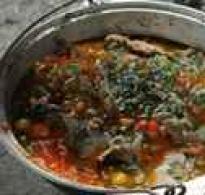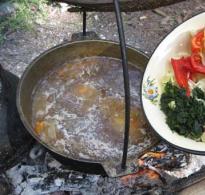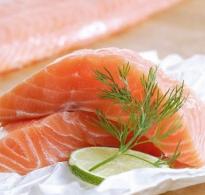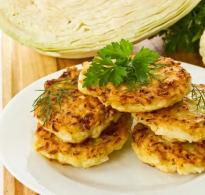How to measure 200 grams of salt. Frequently Asked Question: How Much Salt is in a Teaspoon
If you look in a cookbook, then very often in recipes, the amount of salt required for cooking is indicated in grams. But how can you measure 100 grams of salt if you only have a spoon or a glass at hand? Read on to find out, as today's talk will be about answering this question.
A tablespoon
A tablespoon filled with salt with a slide holds 30 grams. Thus, in order to put exactly 100 grams of salt in the dish, as required by the recipe, it will be necessary to scoop up a little over 3 times from the salt shaker.
The net weight of a 1 tablespoon filled with salt is 25 grams. Thus, the required amount of salt will fit in 4 tablespoons.
A teaspoon
You can measure 100 grams of salt with a teaspoon, but this process will take time and concentration. Agree, gaining 10 spoons (and this is how much it will take to measure 100 grams, since 10 grams of salt fits in a teaspoon filled with a slide), it is extremely important not to lose count. Well, if you fill a spoon without a slide, then you will have to count 15 times at all, because the weight of such a volume is only 7 grams.
Dessert spoon
Often, in order to measure out a hundred grams of salt, hostesses use a dessert spoon. It is very easy to pick up the right amount of spice by filling a spoon with a top - five such spoons will weigh 100 grams (one dessert spoon holds 20 grams of salt). A dessert spoon filled with no slide can hold 14 grams of spice. With the help of simple mathematical calculations, it becomes clear that the required portion of salt is 7 dessert spoons.
Glass
If you think that measuring out 100 grams of salt with spoons, especially teaspoons, is a long and tedious task, then you will like the way to measure out the required amount of spice with a faceted glass. Despite the fact that this dish comes from the USSR, it is quite common even in modern kitchens.
The net weight of a glass filled to the brim with salt is 320 grams, up to risks - 290 grams. Obviously, it is more convenient to start from the last value. Visually divide the volume of the glass to the risks into three equal parts, 1/3 part and will weigh 100 grams, i.e. exactly as much as is required to prepare the dish, the recipe for which you found in the cookbook.
Happy experiments in the kitchen!
Every day a person comes across many recipes for completely different dishes. You can find out about these recipes from TV shows, culinary magazines, and social networks. No matter how different the recipes are, they always contain such an irreplaceable ingredient as salt.
Somewhere in large, somewhere in small quantities, but the fact that it is difficult to cook any food without it remains a fact. How to measure it with the help of improvised means without resorting to kitchen scales?
Table salt on the modern market is represented by a large number of different types. The most common and widely used types are coarse and small.
You can measure these types of salt using a tablespoon. How many grams are in a tablespoon of this product? A level tablespoon holds about 23-25 grams of coarse salt. Small - in a tablespoon will have a weight of approximately 18-20 grams.
How many spoons is 40 grams of salt? By simple mathematical calculations, you can calculate that to select 40 grams of a given bulk substance, you need to collect two tablespoons without a slide. Of course, a lot also depends on the structure of the crystals. If you need to measure out fine salt, it is recommended to take a full two rounded tablespoons.
How many tablespoons do you need to take to measure 20, 60 or 100 grams of salt?
To make it easier to navigate, a convenient table of values is given to help the hostesses:
| The weight | Number of tablespoons with coarse salt | Number of tablespoons with fine salt |
|---|---|---|
| 10 g | 0,4 | 0,5 |
| 20 g | 0,8 | 1 |
| 30 g | 1,2 | 1,5 |
| 50 g | 2 | 2,5 |
| 60 g | 2,4 | 3 |
| 75 g | 3 | 3,75 |
| 80 g | 3,2 | 4 |
| 120 g | 4,8 | 6 |
| 125 g | 5 | 6,25 |
| 150 g | 6 | 7,5 |
| 200 g | 8 | 10 |
| 250 g | 10 | 12,5 |
| 300 g | 12 | 15 |
The value of 40 grams of salt for humans
Salt has played an important role in human life at all times. However, it was not always used for food.
A person needs this element every day. The daily allowance is 2.5 grams.
If a person suffers from diseases of the cardiovascular system, the amount of the daily allowance is reduced to 1.5 grams.
This element is very beneficial in reasonable amounts. He takes an important part in the regulation of the course of biochemical processes in the human body. Thanks to this bulk product, hormones and enzymes are synthesized in the human body.

40 grams of such a substance will have a tremendous effect on a person. This effect will be positive if 40 grams of this element are evenly divided over two weeks. Conversely, the effect will be negative if the person significantly exceeds the daily allowance.
An excess of this element negatively affects the body and human health.
With abuse, a person begins to suffer from diseases of the cardiovascular system, he develops hypertension. Colossal damage is caused to blood vessels in the human body.
However, taking this element in a reasonable amount can help a person stay healthy. In this issue, the main indicator is the measure.
And a little more information on the topic of the article - in the next video.
Often, hostesses strive to please their family members with something new - a fragrant soup or mouth-watering pastries, and maybe a second course. But many experts in the field of food preparation, when composing recipes, indicate the proportional ratio of products in ml or in other units. What to do if you want to do everything according to the recipe, but you cannot measure a certain amount. After all, not every housewife managed to acquire scales for carrying out measured procedures. In addition, practice shows that spoons are the most convenient way to measure the amount of ingredients. Consider how many grams are in a tablespoon of sugar, salt and other ingredients: table will answer all of them and help to solve any problems. At the same time, the article will consider the main indicators of certain ingredients.
Housewives add sea or table salt, so it is important to know the content in a particular container so as not to oversalt the food. It's no secret that the content of different components in the same container will differ. Therefore, it is necessary to know their exact number in order not to miscalculate during the preparation of dishes and to create unique recipes. Considering ordinary table salt, fine, it can be noted that its amount is 22 g without a slide. And 28 gr. with a slight, medium slide. If we take into account rock salt, then it fits a little more due to its light weight. And the indicator is 25/30 gr. respectively.
It's important to know!
The indicator of sea salt and its other types differs from the content of the given type. Therefore, during cooking, the hostess should clarify what kind of salt is contained in the recipe.

How many grams of flour are in a tablespoon
Sometimes flour is added to dishes not in glasses. For example, to make a thick gravy or puree soup, or for other purposes. Usually, the recipes assume premium wheat flour, for a container it is 20 grams. in the minimum case, and 30 g. Sometimes you have to make a replacement (if you are on a diet and the ingredient in the recipe is contraindicated for you, and also if you do not have a suitable type of component at home).
It is important not only to correctly carry out the replacement so as not to disturb the taste, but also to observe the proportions. Therefore, it is important to take into account the correspondence table. It is relevant not only for flour, but also for sugar, salt, and other products. For example, 1 kg of soy flour is equal to 1 kg of wheat. However, 1 kg of refined sugar does not equal 1 kg of granulated sugar or powdered sugar.
It's important to know!
Using the case, consider the proportional content of some other products: 1 kg of butter is represented by the 850th gr. powdered milk, 1 liter of whole milk contains only about 4 liters of condensed milk and so on.
Knowing how much flour to put in a dish can help you prepare delicious meals.
Honey is a product that has proven itself well in the field of folk healing, as well as in the preparation of delicious pastries and other dishes. When weighing honey, special attention should be paid to the volume of the glass, since the amount of weight of the product can be completely different.
It's important to know!
For the convenience of using various ingredients, there is a special table. Of course, you can remember its meanings, but it is not necessary to do this: it is enough to store this tool in the kitchen near the desktop, so that during cooking at any time you can look in and find the necessary content of any components.
This summary record will help to translate the capacity into weights from volumetric criteria. And also to measure the weight characteristics without the need for a balance. Based on the tabular data, it turned out that the presented container contains 25 g of honey without a slide.

9% vinegar is widely used in baked goods to slake baking soda, as well as in the preparation of canned food for the winter. Apple cider vinegar (of course, here the slide is not taken into account) contains 13 g. This indicator is of particular importance, since too much vinegar usually negatively affects the overall taste of any dish. And also on the health of people who eat it. 
How many grams of sugar are in a tablespoon
The generally accepted meaning of "Art. l. sugar "- means the presence of a small slide in it. In rare cases, it is absent, this is necessarily stated in the recipe. This takes into account standard size dishes. Based on the calculations of specialists, the following data was obtained.
- 1 container is 20 and 25 grams. respectively;
- powder "hides" 22 g and 28 g. without and with the presence of a slide.
There are other types, for example, crushed product or refined sugar, their quantity is different, however, powder or sand is usually used for preparation. Knowing this indicator for sugar plays an important role. As many have tried dishes with a lot of sugar and they don't seem delicious. Therefore, it is necessary to strictly observe the proportions.
Olive and sunflower vegetable oils are more commonly used, but other varieties can often be used. For sunflower oil for one dish, the weight indicator is 12 g. It is necessary to know this for preparing salads and dressings for them. And also in order to create delicious soups, side dishes and meat dishes. 
If there is no scale in the kitchen, our plate is always available for the hostesses. In which it is clearly noted how many dimensional units are in the container. This tool is convenient to use in any situation. We recommend that you print the values, put them in the kitchen and keep them handy for all occasions.
Weight characteristics of other products table
It also shows how many other types of food are contained in the proposed dishes.
- Ordinary tap water - 18 g;
- Peanuts peeled from the shell - 25 g. Also, this weight has raisins, citric acid, cocoa powder, fresh strawberries, sour cream, egg powder (melange);
- Any jam is placed in an amount of 50 grams, the same applies to strawberry puree and some other products.
- If you decide to please yourself and your loved ones with an exquisite cherry dish, then it contains 30 grams. fresh. The same indicator is found in the kernel of almonds, condensed milk, potato and wheat first-class flour, salt.
- 20 g each is contained in the following products: ground cinnamon and coffee, liqueur, poppy seeds, milk powder, sago.
Possession of this information will allow you not only to cook deliciously, but also to develop your culinary skills in the future.

Have you yourself estimated how many grams are in a tablespoon of sugar, salt and other bulk products? Did our table help you? Leave your opinion or feedback for everyone on the forum!
"How many tablespoons is 100 grams of salt?" - a question that more than once confused thousands of housewives standing over a half-prepared dish.
Yes, often women are faced with the need to put a certain gramme of something in their next culinary masterpiece, more often sugar, salt or spices. If you have a kitchen scale, the problem is quickly resolved, but what to do in the absence of special equipment? The answer is simple - measure with spoons! Most cookbooks list recipes in grams, and there is no mention of how to transfer these measurements to cutlery. In our article you will find brief instructions on measuring salt with a tea, dessert and tablespoon, as well as a faceted glass.
Tea spoon
You can measure 100 grams of salt with a teaspoon. But such a process requires special care and concentration. It is very important not to lose count, because for a set of 100 grams of salt you will have to take 10 full heaped spoons. Carrying them is not very convenient, so some people prefer to count 15 flat spoons. Which, of course, is even more complicated. The conclusion follows from this: there are 7 grams of salt in one teaspoon.Dessert spoon
Measuring in this way is not the most convenient, but still better than the previous one. One dessert spoon of top salt is exactly 20 grams of salt. In the absence of a slide - 14 gr. Using simple mathematical calculations, we can determine: 100 grams of salt is 5 dessert spoons.Tablespoon
A tablespoon is one of the most commonly used items in this business. Especially when it comes to preservation, cooking large quantities of first courses or salting fish and meat. Agree, boiling a bucket of brine, while throwing spices with a teaspoon, is not very convenient.To get 100 grams of salt, you will have to scoop up a spoonful of salt 3.5 times from the salt shaker. Because one tablespoon holds 30 grams of salt.
Faceted glass
For housewives who do not have special care or who think that measuring with spoons is too tedious, we recommend using a glass. Despite the fact that such a vessel comes from the distant USSR, it is quite often found in our kitchens.The weight of the content that completely fills the faceted glass is 320 grams. If the container is filled only to the horizontal mark, the net weight is 290 grams. Based on the latter indicator, it is easy to determine 100 g of salt. To do this, it is necessary to visually divide the container into three even parts, each of which will be the required amount.
Remember, experimenting in the kitchen often makes cooking easier. If you make friends with a spoon and a glass, the question "100 grams of salt, how many tablespoons" will disappear by itself.
In recipes, ingredients are often listed in grams. For example, you need to take 200 g of flour or 7 g of soda. Accuracy, of course, is a good thing, it is not for nothing that it is called "the courtesy of kings." But how to measure the right amount of food if you don't have an electronic scale at hand?
It is even more difficult if the components are indicated "by eye". How much is "an incomplete glass of milk", "a pinch of ground pepper" or "soda on the tip of a knife"? The dishes and the eye are different for everyone, and measuring devices for determining the exact weight are not found in every kitchen.
One of the most sought-after ingredients in cooking is common table salt. It is this component that needs accurate dosage.
If you put a little, it won't taste good; if you oversalt it, it's even worse, the dish is irreparably spoiled.
The easiest way is to measure with a teaspoon. And if the weight is indicated with an accuracy of a gram, how to get out of the situation? It's very simple, you need to know how many grams of salt are in a teaspoon (standard)?
It would seem elementary, but few people know the answer to this question. Moreover, salt can be of different grind - coarse and fine. And you can put it in different ways - flush with the edges or with an addition - "with a slide."

How much to "hang in grams"
It is easy to remember that a regular teaspoon contains 7 grams of free-flowing salt crystals. This is if it is medium or small.

The same device "with the top" will "pull" 10 grams. Coarse crystals are heavier and more voluminous. A teaspoon of them fits less, only 5 grams.
It should be borne in mind that recipes usually use a “heaped” dosage by default.
Otherwise, usually indicate "spoon without top", "incomplete spoon" or simply "1 tsp." How much this is by weight - you already know.
In almost all types of dough, salt is added to improve its taste and texture.
Often, the baking recipe indicates not the measure of the volume of bulk products, but the weight. Knowing how much product is in a teaspoon, you will never ruin a cake, cookies or delicious kulebyaka.
There are 38 parrots in a boa constrictor, but how many teaspoons are in the dining room?
What to do if the amount of salt in the food is indicated in tablespoons, and you only have a teaspoon at hand? Agree, the most unforeseen situations are possible in life.
Memorize or write down: in an ordinary tablespoon measuring 7 cm by 4 cm - 25 g of salt.
The same cutlery "top" holds 30 g of spice, without which life seems bland. The weight of large crystals, respectively, is 20 g.
For clarity, we present a table. It can be saved and used as needed.
Fine to medium-sized salt:
Coarse salt:
Knowing the general proportions, it is not difficult to determine any amount of the most common spice. For example, you need to measure 2 g.

Our salt is fine, which means that in a teaspoon - 10 g.
Therefore, we take 1/5 part.
Such a simple everyday trick will help you not to be too clever with spices. Moreover, according to popular wisdom, "salted is on the back, and not salted is on the table." The shortage is easy to fix, but the surplus is almost impossible.
All tricks with the addition of water or rice in a linen bag, which should draw out excess salt, are not very effective. It is better to follow the measure right away.
In addition - a short video on the topic of the article.






